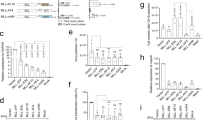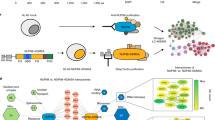Abstract
The chromosomal translocation t(4;11)(q21;q23) is a frequent genetic aberration of the mixed lineage leukemia (MLL) gene, predominantly associated with high-risk acute lymphoblastic leukemia (ALL) in pediatric patients. Previous studies demonstrated that mice transplanted with hematopoietic cells expressing the AF4–MLL fusion protein develop proB ALL. The AF4–MLL oncoprotein becomes activated by Taspase1-mediated hydrolysis, which subsequently leads to a heterodimer of the cleavage products AF4–MLL·N and MLL·C. This protein–protein interaction is due to the FYRN and FYRC interaction domains present in both protein fragments. Heterodimerization subsequently induces high-molecular-weight protein complex formation that is protected against SIAH1/2-mediated polyubiquitinylation. Here, we attempted to selectively block this initial heterodimerization step, aiming to prevent the oncogenic activation of the AF4–MLL multiprotein complex. The minimal interaction interface was experimentally defined first in a bacterial two-hybrid system, and then in mammalian cells by using a biosensor assay. Expression of the FYRC domain, or smaller portions thereof, resulted in the inhibition of heterodimer formation, and blocked AF4–MLL multiprotein complex formation with subsequent destruction of the AF4–MLL oncoprotein. Thus, it is in principle possible to specifically target the AF4–MLL protein. This knowledge can now be exploited to design inhibitory decoys in order to destroy the AF4–MLL oncoprotein.
This is a preview of subscription content, access via your institution
Access options
Subscribe to this journal
Receive 12 print issues and online access
$259.00 per year
only $21.58 per issue
Buy this article
- Purchase on Springer Link
- Instant access to full article PDF
Prices may be subject to local taxes which are calculated during checkout





Similar content being viewed by others
References
Meyer C, Kowarz E, Hofmann J, Renneville A, Zuna J, Trka J et al. New insights to the MLL recombinome of acute leukemias. Leukemia 2009; 23: 1490–1499.
Nilson I, Reichel M, Ennas MG, Greim R, Knörr C, Siegler G et al. The exon/intron structure of the human AF-4 gene, a member of the AF-4/LAF-4/FMR-2 gene family coding for a nuclear protein with structural alterations in acute leukemia. Brit J Haematol 1987; 98: 157–169.
Kowarz E, Burmeister T, Nigro LL, Jansen MWJC, Delabesse E, Klingebiel T et al. Complex MLL rearrangements in MLL·AF4+/AF4·MLL- leukemia patients conceal the presence of reciprocal MLL fusion genes. Leukemia 2007; 21: 1232–1238.
Scharf S, Zech J, Bursen A, Schraets D, Oliver PL, Kliem S et al. Transcription links to recombination: a gene-internal promoter coincides with the recombination hotspot II of the human MLL gene. Oncogene 2007; 26: 1361–1371.
Chen W, Li Q, Hudson WA, Kumar A, Kirchhof N, Kersey JH . A murine Mll-AF4 knock-in model results in lymphoid and myeloid deregulation and hematologic malignancy. Blood 2006; 108: 669–677.
Metzler M, Forster A, Pannell R, Arends MJ, Daser A, Lobato MN et al. A conditional model of MLL-AF4 B-cell tumourigenesis using invertor technology. Oncogene 2006; 25: 3093–3103.
Xia ZB, Popovic R, Chen J, Theisler C, Stuart T, Santillan DA et al. The MLL fusion gene, MLL-AF4, regulates cyclin-dependent kinase inhibitor CDKN1B (p27kip1) expression. Proc Natl Acad Sci USA 2005; 102: 14028–14033.
Milne TA, Hughes CM, Lloyd R, Yang Z, Rozenblatt-Rosen O, Dou Y et al. Menin and MLL cooperatively regulate expression of cyclin-dependent kinase inhibitors. Proc Natl Acad Sci USA 2005; 102: 749–754.
Krivtsov AV, Feng Z, Lemieux ME, Faber J, Vempati S, Sinha AU et al. H3K79 methylation profiles define murine and human MLL-AF4 leukemias. Cancer Cell 2008; 14: 355–368.
Bursen A, Moritz S, Gaussmann A, Moritz S, Dingermann T, Marschalek R . Interaction of AF4 wild-type and AF4·MLL fusion protein with SIAH proteins: indication for t(4;11) pathobiology? Oncogene 2004; 23: 6237–6249.
Gaussmann A, Wenger T, Eberle I, Bursen A, Bracharz S, Herr I et al. Combined effects of the two reciprocal t(4;11) fusion proteins MLL·AF4 and AF4-MLL confer resistance to apoptosis, cell cycling capacity and growth transformation. Oncogene 2007; 26: 3352–3363.
Bursen A, Schwabe K, Rüster B, Henschler R, Ruthardt M, Dingermann T et al. The AF4-MLL fusion protein is capable of inducing ALL in mice without requirement of MLL-AF4. Blood 2010; 115: 3570–3579.
Benedikt A, Baltruschat S, Scholz B, Bursen A, Arrey TN, Meyer B et al. The leukemogenic AF4-MLL fusion protein causes P-TEFb kinase activation and altered epigenetic signatures. Leukemia 2010; 25: 135–144.
Hsieh JJD, Cheng EHY, Korsmeyer SJ . Taspase1: a threonine aspartase required for cleavage of MLL and proper HOX gene expression. Cell 2003a; 115: 293–303.
Yokoyama A, Kitabayashi I, Ayton PM, Cleary ML, Ohki M . Leukemia proto-oncoprotein MLL is proteolytically processed into 2 fragments with opposite transcriptional properties. Blood 2002; 100: 3710–3718.
Hsieh JJ, Ernst P, Erdjument-Bromage H, Tempst P, Korsmeyer SJ . Proteolytic cleavage of MLL generates a complex of N- and C-terminal fragments that confers protein stability and subnuclear localization. Mol Cell Biol 2003b; 23: 186–194.
Doerks T, Copley RR, Schultz J, Ponting C, Bork P . Systematic identification of novel protein domain families associated with nuclear functions. Genome Res 2002; 12: 47–56.
García-Alai M, Allen D, Joerger A, Bycroft M . The structure of the FYR domains of transforming growth factor beta regulator 1 (TBRG1). Protein Science 2010; 17: 1432–1438.
Kohoutek J . P-TEFb- the final frontier. Cell Div 2009; 4: 19.
Peterlin BM, Price DH . Controlling the elongation phase of transcription with P-TEFb. Mol Cell 2006; 23: 297–305.
Marshall NF, Price DH . Purification of P-TEFb, a transcription factor required for the transition into productive elongation. J Biol Chem 1995; 270: 12335–12338.
Bier C, Knauer SK, Klapthor A, Schweitzer A, Rekik A, Krämer OH et al. Cell-based analysis of structure-function activity of Threonine Aspartase 1. J Biol Chem 2010, e-pub ahead of print.
Knauer SK, Stauber RH . Development of an autofluorescent translocation biosensor system to investigate protein-protein interactions in living cells. Anal Chem 2005; 77: 4815–4820.
Meyer C, Kowarz E, Schneider B, Oehm C, Klingebiel T, Dingermann T et al. Genomic DNA of leukemic patients: target for clinical diagnosis of MLL rearrangements. Biotechnol J 2006; 1: 656–663.
Bitoun E, Oliver PL, Davies KE . The mixed-lineage leukemia fusion partner AF4 stimulates RNA polymerase II transcriptional elongation and mediates coordinated chromatin remodeling. Hum Mol Genet 2007; 16: 92–106.
Acknowledgements
This work has been supported by grant 102363 from the Deutsche Krebshilfe e.V. to RM and RS. The biosensor assay has been established with the support of Boehringer Ingelheim and Wilhelm-Sander Foundation, Funds of the Chemical Industry, and the Stiftung Rheinland-Pfalz für Innovationen.
Author information
Authors and Affiliations
Corresponding author
Ethics declarations
Competing interests
The authors declare no conflict of interest.
Additional information
Supplementary Information accompanies the paper on the Leukemia website
Supplementary information
Rights and permissions
About this article
Cite this article
Pless, B., Oehm, C., Knauer, S. et al. The heterodimerization domains of MLL—FYRN and FYRC—are potential target structures in t(4;11) leukemia. Leukemia 25, 663–670 (2011). https://doi.org/10.1038/leu.2010.308
Received:
Revised:
Accepted:
Published:
Issue Date:
DOI: https://doi.org/10.1038/leu.2010.308
Keywords
This article is cited by
-
Structure, function and inhibition of critical protein–protein interactions involving mixed lineage leukemia 1 and its fusion oncoproteins
Journal of Hematology & Oncology (2021)
-
Novel mutations in KMT2B offer pathophysiological insights into childhood-onset progressive dystonia
Journal of Human Genetics (2019)
-
Taspase1: a 'misunderstood' protease with translational cancer relevance
Oncogene (2016)
-
SIAH proteins: critical roles in leukemogenesis
Leukemia (2013)
-
Chemico-genetic strategies to inhibit the leukemic potential of threonine aspartase-1
Blood Cancer Journal (2012)



